Hello! Welcome! Bienvenue!
This is the class website for Division 3 at UHE! Here you will find posts about what we are doing, helpful links, our “Homework Board,” ePortfolios, and more!
Here are some reminders and information as we enter into our new school year.
Outdoor Recess/Lunch Times
Students will be outside during recess and lunch, rain or shine. Encourage your child to become increasingly 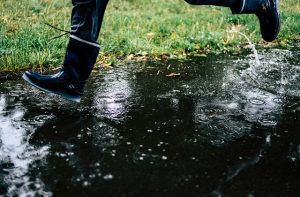 involved with planning for what they need for their time outside. Proper rain gear, and even a change of clothing, can make a big difference in comfort for the rest of the day!
involved with planning for what they need for their time outside. Proper rain gear, and even a change of clothing, can make a big difference in comfort for the rest of the day!
Planners
Each day students will write about homework/reminders in their planner. We are learning to determine what we need to record, and how to plan for and organize our goals. After writing in their planners at school, I will initial each planner and add or ask about any details. It is each student’s responsibility to share their planner with an adult at home, and to provide the adult with a pen or pencil to sign.
Please see our online “Homework Board” here.
P.E. Strip
Students will be required to change their clothing and ensure they have appropriate non-marking footwear for the gym. They can change into t-shirts, sweatshirts, shorts, leggings, or sweatpants–clothing for movement! They will keep their P.E. strip in a cloth bag, and bring it home on weekends to wash.
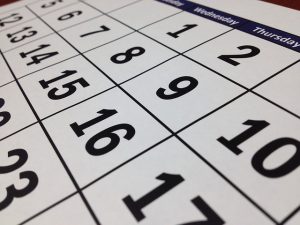 Schedule
Schedule
We are still in the process of finalizing schedules for P.E., Music, Library, etc. Once these are in place, we will be able to fit all the other puzzle pieces together.
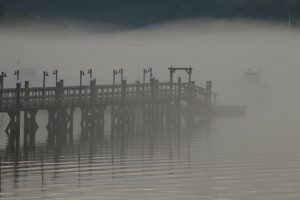 Fog
Fog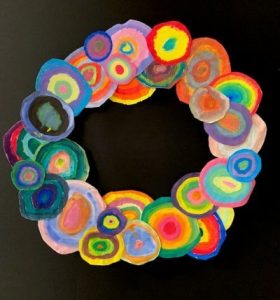 Our class wreath for Remembrance Day is based on Wassily Kandinsky’s work Squares with Coloured Circles (Farbstudie – Quadrate und konzentrische Ringe), 1913. Even though this piece could be considered Kandinsky’s most famous creation, it was not originally intended to be an entire composition. It was a study of how colours interacted with each other in various combinations. Kandinksy was a synesthete–he could hear colours, and see sounds. Colour tells its own story to each person, and to Kandinsky, colour meant more than just a visual component of a picture.
Our class wreath for Remembrance Day is based on Wassily Kandinsky’s work Squares with Coloured Circles (Farbstudie – Quadrate und konzentrische Ringe), 1913. Even though this piece could be considered Kandinsky’s most famous creation, it was not originally intended to be an entire composition. It was a study of how colours interacted with each other in various combinations. Kandinksy was a synesthete–he could hear colours, and see sounds. Colour tells its own story to each person, and to Kandinsky, colour meant more than just a visual component of a picture.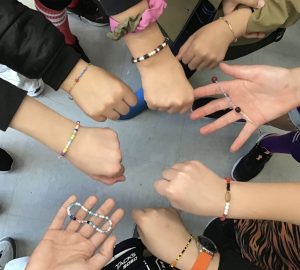 In September students learned how to write numbers in binary (a base-2 number system). Today students learned that letters can also be coded in binary! Each student mapped out their names on grid paper, chose their colours, and beaded their names into a bracelet.
In September students learned how to write numbers in binary (a base-2 number system). Today students learned that letters can also be coded in binary! Each student mapped out their names on grid paper, chose their colours, and beaded their names into a bracelet.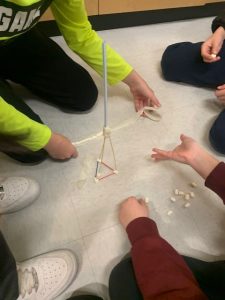

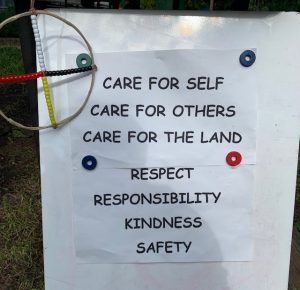 First we looked at the Medicine Wheel, which symbolizes life in a continuous natural cycle. The Medicine Wheel represents the four directions, the four seasons, the four elements, and all of humanity. People are part of the Earth, just as are the plants, animals, air, water, and rocks around us. It is important that we establish healthy relationships with all of these parts.
First we looked at the Medicine Wheel, which symbolizes life in a continuous natural cycle. The Medicine Wheel represents the four directions, the four seasons, the four elements, and all of humanity. People are part of the Earth, just as are the plants, animals, air, water, and rocks around us. It is important that we establish healthy relationships with all of these parts.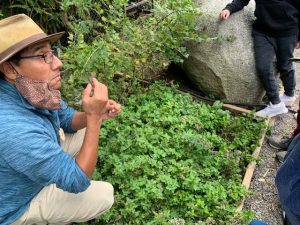 Pablo reviewed the expectations for the garden, and then we got to work harvesting quite a few different types of vegetables!
Pablo reviewed the expectations for the garden, and then we got to work harvesting quite a few different types of vegetables!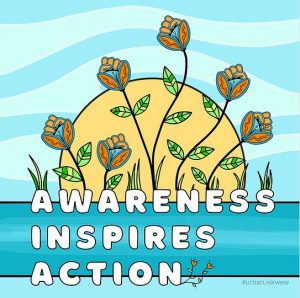

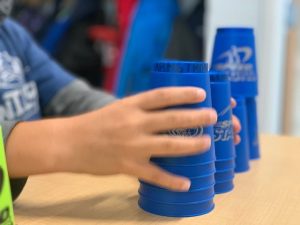
 involved with planning for what they need for their time outside. Proper rain gear, and even a change of clothing, can make a big difference in comfort for the rest of the day!
involved with planning for what they need for their time outside. Proper rain gear, and even a change of clothing, can make a big difference in comfort for the rest of the day! Schedule
Schedule